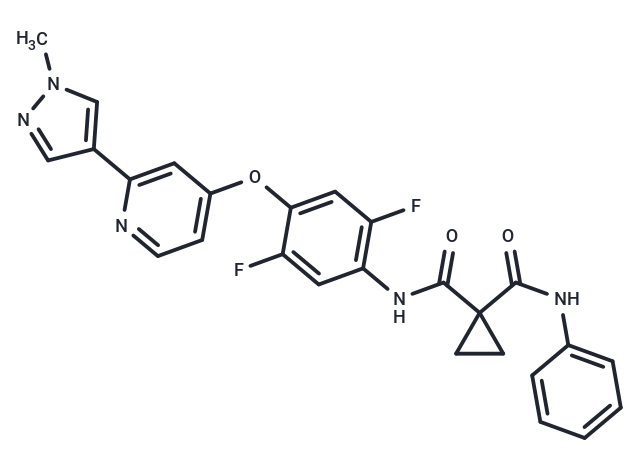Shopping Cart
- Remove All
 Your shopping cart is currently empty
Your shopping cart is currently empty
c-Kit-IN-1 (DCC-2618) is an effective inhibitor of c-Met and c-Kit (IC50s<200 nM).

| Pack Size | Price | Availability | Quantity |
|---|---|---|---|
| 1 mg | $35 | In Stock | |
| 5 mg | $79 | In Stock | |
| 10 mg | $129 | In Stock | |
| 25 mg | $262 | In Stock | |
| 50 mg | $419 | In Stock | |
| 100 mg | $676 | In Stock | |
| 200 mg | $943 | In Stock | |
| 1 mL x 10 mM (in DMSO) | $84 | In Stock |
| Description | c-Kit-IN-1 (DCC-2618) is an effective inhibitor of c-Met and c-Kit (IC50s<200 nM). |
| Targets&IC50 | c-Kit:<200 nM, c-Met:<200 nM |
| In vitro | DCC-2618 also inhibits KDR and PDGFR α/β (IC50s: <2 μM, <10 μM and <10 μM). |
| Kinase Assay | The activity of c-KIT kinase is determined by following the production of ADP from the kinase reaction through coupling with the pyruvate kinase/lactate dehydrogenase system. In this assay, the oxidation of NADH (thus the decrease at A340 nM) is continuously monitored spectrophotometrically. The reaction mixture (100 μL) contained c-KIT (cKIT residues T544-V976, from ProQinase, 5.4 nM), polyE4Y (1 mg/mL), MgC12 (10 mM), pyruvate kinase (4 units), lactate dehydrogenase (0.7 units), phosphoenol pyruvate (1 mM), and NADH (0.28 mM) in 90 mM Tris buffer containing 0.2 % octyl-glucoside and 1% DMSO, pH 7.5. Test compounds (e.g., DCC-2618) are incubated with c-KIT and other reaction reagents at 22 °C for < 2 min before ATP (200 μM) is added to start the reaction. The absorption at 340 nm is monitored continuously for 0.5 hours at 30 °C on Polarstar Optima plate reader (BMG). The reaction rate is calculated using the 0 to 0.5 h time frame. Percent inhibition is obtained by comparison of reaction rate with that of a control (i.e. with no test compound). |
| Cell Research | DCC-2618 is prepared in DMSO and stored, and then diluted with the appropriate medium before use.A serial dilution of test compounds (e.g., DCC-2618) is dispensed into a 96-well black clear bottom plate. For each cell line, five thousand cells are added per well in 200 μL complete growth medium. Plates are incubated for 67 hours at 37 degrees Celsius, 5% CO2, 95% humidity. At the end of the incubation period, 40 μL of a 440 μM solution of resazurin in PBS is added to each well and incubated for an additional 5 hours at 37 degrees Celsius, 5% CO2, 95% humidity. Plates are read on a Synergy2 reader using an excitation of 540 nM and an emission of 600 nM. |
| Synonyms | PDGFR inhibitor 1, DCC-2618 |
| Molecular Weight | 489.47 |
| Formula | C26H21F2N5O3 |
| Cas No. | 1225278-16-9 |
| Smiles | Cn1cc(cn1)-c1cc(Oc2cc(F)c(NC(=O)C3(CC3)C(=O)Nc3ccccc3)cc2F)ccn1 |
| Relative Density. | 1.40 g/cm3 at 20℃ |
| Storage | Powder: -20°C for 3 years | In solvent: -80°C for 1 year | Shipping with blue ice/Shipping at ambient temperature. | |||||||||||||||||||||||||||||||||||
| Solubility Information | DMSO: 88 mg/mL (179.79 mM), Sonication is recommended. | |||||||||||||||||||||||||||||||||||
Solution Preparation Table | ||||||||||||||||||||||||||||||||||||
DMSO
| ||||||||||||||||||||||||||||||||||||

Copyright © 2015-2025 TargetMol Chemicals Inc. All Rights Reserved.